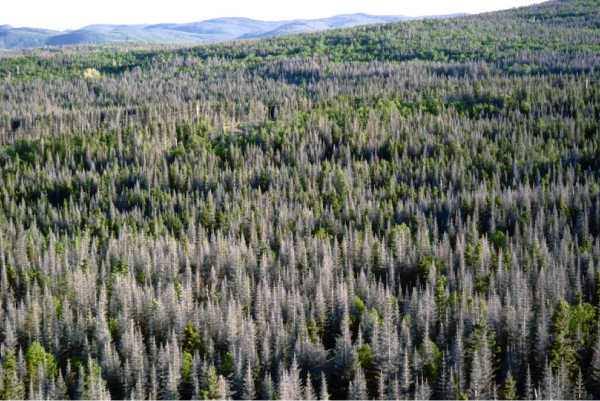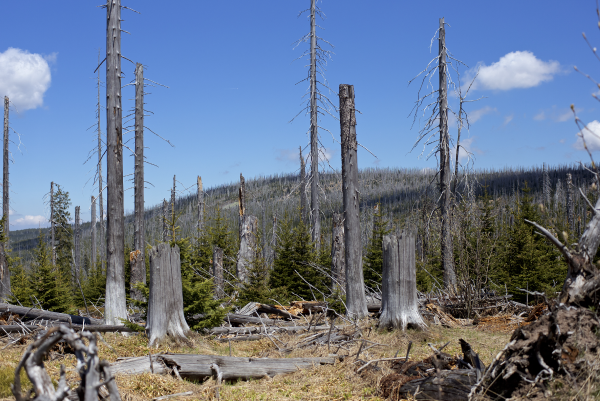To access the other sheets in the Forest Regions unit, check out the See Also section.
There are natural phenomena that can cause damage to forest ecosystems.
-
A natural phenomenon is an event that occurs in nature, without any human intervention. This could be an earthquake, hurricane, aurora borealis, etc.
-
An ecosystem refers to all of the connections in a physical environment and the organisms that live in it.
These threats include:
-
fires caused by natural elements, such as lightning,
-
insect infestations,
-
floods,
-
droughts,
-
high winds,
-
tornadoes,
-
hurricanes,
-
diseases.

This insect attacks a coniferous tree’s buds and needles. It kills many conifers in North American forests. Spruce budworm epidemics are cyclical, occuring in Quebec every 30 years or so.
Source: Une photo montrant les arbres morts en raison de la tordeuse des bourgeons de l’épinette [Photography], Ministère des Forêts, de la Faune et des Parcs, s.d., Radio-Canada, (URL). Rights Reserved*
There are phenomena caused by humans that can damage forest ecosystems.
Some of these threats can cause damage in a very short period of time, such as fires. Others can have short- or long-term negative consequences, such as:
-
acid rain,
-
deforestation,
-
mining,
-
the introduction of foreign animals and plants that are harmful to native species.
-
Deforestation refers to the human action of permanently eliminating an area of forest.
-
A native species, in ecology, refers to a plant or animal species that naturally grows or lives in a particular region.
In 1896, Henri Menier introduced white-tailed deer to Anticosti, in Quebec. This foreign animal species had negative impacts on native plant species on this island.
On Anticosti, the white-tailed deer has no predators so its population exploded. This led to the reduction, and even disappearance, of certain types of trees and bushes that this animal feeds on.
To access the rest of the unit, you can consult the following concept sheets.
Ministère des Forêts, de la Faune et des Parcs. (n.d.). Une photo montrant les arbres morts en raison de la tordeuse des bourgeons de l’épinette [Photography]. Radio-Canada. https://ici.radio-canada.ca/nouvelle/1125093/tordeuse-bourgeon-epinette-sopfim-foret *Excerpt used by Alloprof in accordance with the Copyright Act for fair use for educational purposes.
